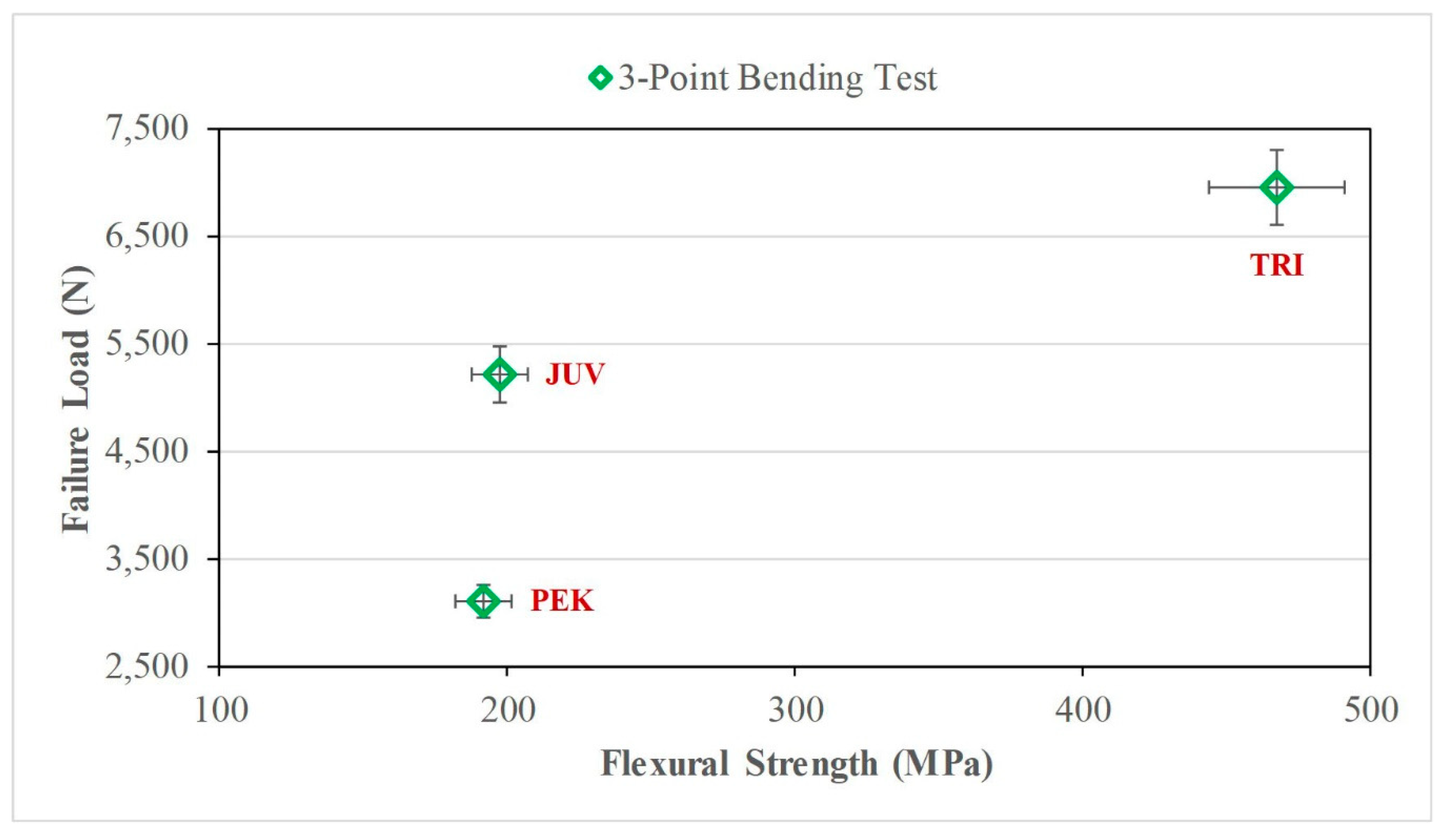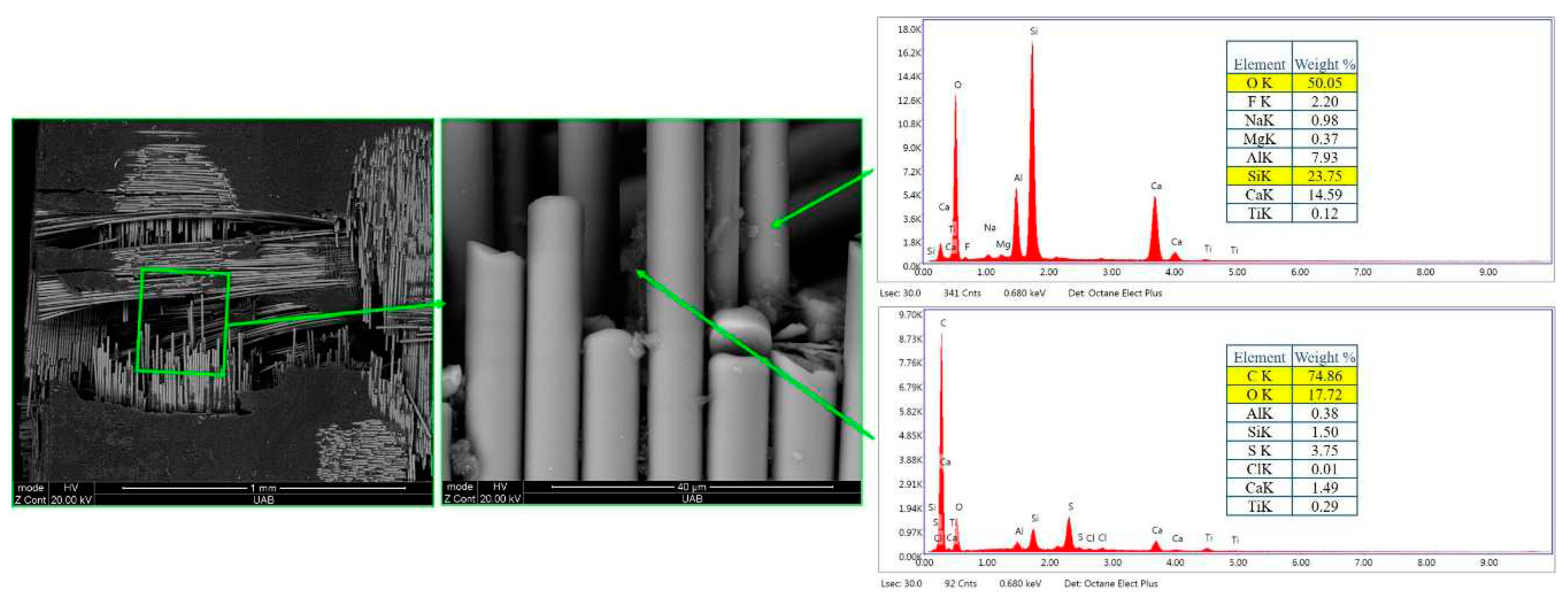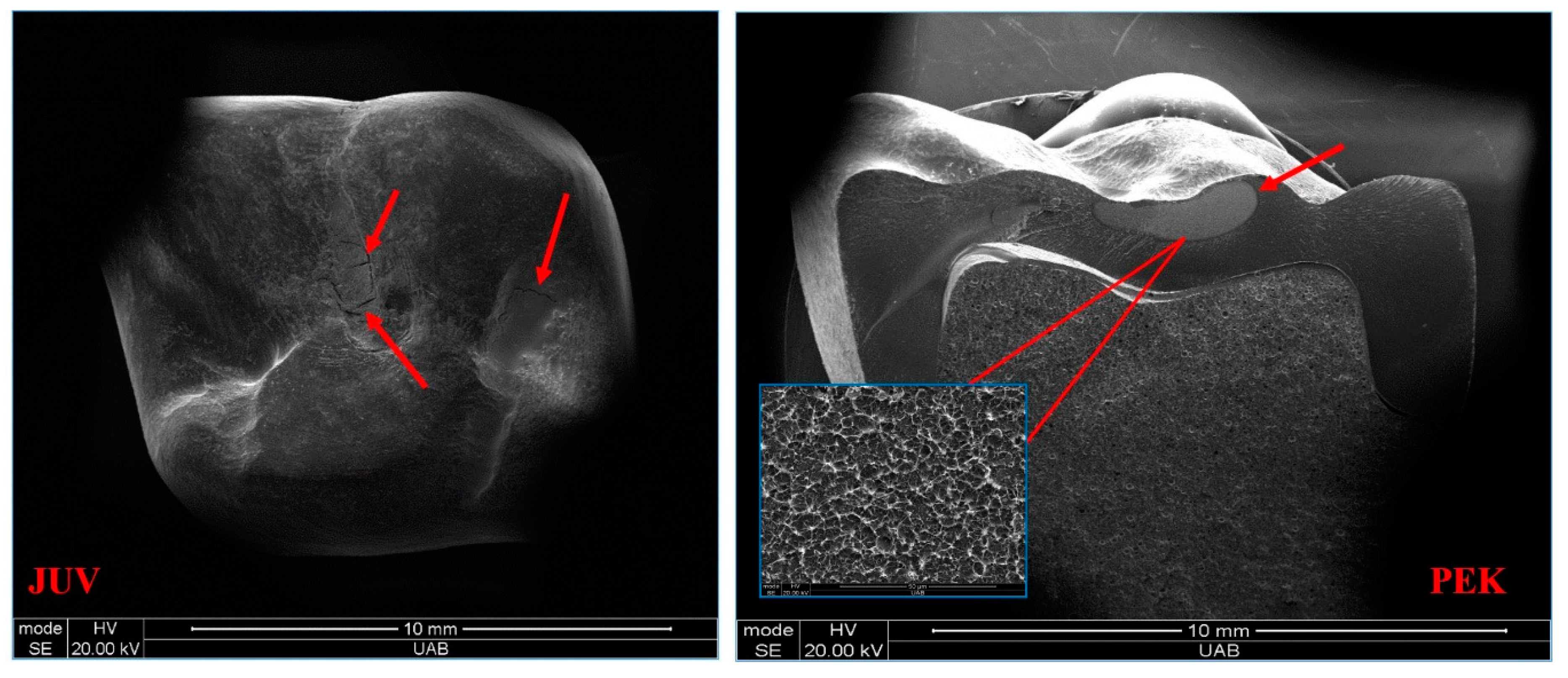Submitted:
28 September 2023
Posted:
28 September 2023
You are already at the latest version
Abstract
Keywords:
1. Introduction
2. Material and Methods
3. Results
4. Discussion
5. Conclusions
- The flexural strength of the bars did not correlate with the corresponding failure load of the crowns.
- The TRI had a higher failure load and flexural strength than JUV and PEK, likely due to the presence of woven glass fiber (63 wt%) reinforced composite resin.
- The JUV specimens failed by deformation only, while the TRI specimens failed by deformation and cracks. The PEK specimens failed by fracture.
References
- Wang F, Guo J, Li K, Sun J, Zeng Y, Ning C. High strength polymer/silicon nitride composites for dental restorations. Dent Mater. 2019, 35, 1254–1263. [Google Scholar] [CrossRef] [PubMed]
- Mayinger F, Eichberger M, Schönhoff LM, Stawarczyk B. Fracture load of veneered and monolithic single-unit fixed dental prostheses made from the high-performance thermoplastic polyphenylene sulfone. Int J Prosthodont. 2021.
- Karci M, Demir N, Yazman S. Evaluation of flexural strength of different denture base materials reinforced with different nanoparticles. J Prosthodont. 2019, 28, 572–579. [Google Scholar] [CrossRef] [PubMed]
- Psarri C, Kourtis S. Effect of fiber-reinforcement on the strength of polymer materials for provisional restorations: An in vitro study. J Esthet Restor Dent. 2020, 32, 433–440. [Google Scholar] [CrossRef]
- Li GH, Chen S, Grymak A, Waddell JN, Kim JJ, Choi JJE. Fibre-reinforced and repaired PMMA denture base resin: Effect of placement on the flexural strength and load-bearing capacity. J Mech Behav Biomed Mater. 2021, 124, 104828. [Google Scholar]
- Alander P, Perea-Lowery L, Vesterinen K, Suominen A, SÄilynoja E, Vallittu PK. Layer structure and load-bearing properties of fibre reinforced composite beam used in cantilever fixed dental prostheses. Dent Mater J. 2021, 40, 165–172. [Google Scholar] [CrossRef] [PubMed]
- Suzaki N, Yamaguchi S, Hirose N, Tanaka R, Takahashi Y, Imazato S, Hayashi M. Evaluation of physical properties of fiber-reinforced composite resin. Dent Mater. 2020, 36, 987–996. [Google Scholar] [CrossRef]
- Maruo Y, Nishigawa G, Irie M, Yoshihara K, Minagi S. Flexural properties of polyethylene, glass and carbon fiber-reinforced resin composites for prosthetic frameworks. Acta Odontol Scand. 2015, 73, 581–587. [Google Scholar] [CrossRef]
- Dawson JH, Hyde B, Hurst M, Harris BT, Lin WS. Polyetherketoneketone (PEKK), a framework material for complete fixed and removable dental prostheses: A clinical report. J Prosthet Dent. 2018, 119, 867–872. [Google Scholar] [CrossRef]
- Rodríguez V, Tobar C, López-Suárez C, Peláez J, Suárez MJ. Fracture load of metal, zirconia and polyetheretherketone posterior CAD-CAM milled fixed partial denture frameworks. Materials (Basel). 2021, 14, 959. [Google Scholar] [CrossRef]
- Raj DA, Chander NG, Reddy JR, Balasubramaniam M. Clinical acceptability of PEEK fixed dental prosthesis in partially edentulous patient - A one year single arm pilot study. J Oral Biol Craniofac Res. 2020, 10, 523–528. [Google Scholar] [CrossRef]
- Shetty SK, Hasan MS, Zahid M, Suhaim KS, Mohammad F, Fayaz T. Evaluation of fracture resistance and color stability of crowns obtained by layering composite Over zirconia and polyetheretherketone copings before and after thermocycling to simulate oral environment: An in vitro study. J Pharm Bioallied Sci. 2020, 12, S523–S529.
- Shrivastava SP, Dable R, Raj APN, Mutneja P, Srivastava SB, Haque M. Comparison of mechanical properties of PEEK and PMMA: An In Vitro Study. J Contemp Dent Pract. 2021, 22, 179–183. [Google Scholar] [CrossRef]
- Al-Rabab’ah M, Hamadneh W, Alsalem I, Khraisat A, Abu Karaky A. Use of high-performance polymers as dental implant abutments and frameworks: A case series report. J Prosthodont 2019, 28, 365–372. [Google Scholar] [CrossRef]
- Barbosa-Júnior SA, Pereira GKR, Dapieve KS, Machado PS, Valandro LF, Schuh C, Consani RLX, Bacchi A. Mechanical fatigue analysis of PEEK as alternative to zirconia for definitive hybrid abutments supporting all-ceramic crowns. Int J Oral Maxillofac Implants. 2020, 35, 1209–1217. [Google Scholar] [CrossRef]
- Papia E, Brodde SAC, Becktor JP. Deformation of polyetheretherketone, PEEK, with different thicknesses. J Mech Behav Biomed Mater. 2022, 125, 104928. [Google Scholar]
- Özarslan M, Büyükkaplan UŞ, Özarslan MM. Comparison of the fracture strength of endodontically treated teeth restored with polyether ether ketone, zirconia and glass-fibre post-core systems. Int J Clin Pract. 2021, 75, e14440. [Google Scholar]
- Abd El-Fattah A, Youssef H, Gepreel MAH, Abbas R, Kandil S. Surface morphology and mechanical properties of Polyether Ether Ketone (PEEK) nanocomposites reinforced by nano-sized silica (SiO (2)) for prosthodontics and restorative dentistry. Polymers (Basel). 2021, 13, 3006. [Google Scholar] [CrossRef] [PubMed]
- Villefort RF, Diamantino PJS, von Zeidler SLV, Borges ALS, Silva-Concílio LR, de Siqueira Ferreira Anzaloni Saavedra G, Tribst JPM. Mechanical response of PEKK and PEEK as frameworks for implant-supported full-arch fixed dental prosthesis: 3D finite element analysis. Eur J Dent. 2021.
- Klur T, Hasan I, Ottersbach K, Stark H, Fichte M, Dirk C, Bourauel C. PEKK-made indirect temporary crowns and bridges: A clinical pilot study. Clin Oral Investig. 2019, 23, 771–777. [Google Scholar] [CrossRef]
- Shams A, Sakrana AA, Abo El-Farag SA, Özcan M. Assessment of biomechanical behavior of endodontically treated premolar teeth restored with novel endocrown system. Assessment of biomechanical behavior of endodontically treated premolar teeth restored with novel endocrown system. Eur J Prosthodont Restor Dent. 2021.
- Rohr N, Märtin S, Fischer J. Fracture load of zirconia implant supported CAD/CAM resin crowns and mechanical properties of restorative material and cement. J Prosthodont Res. 2021, 65, 502–508. [Google Scholar] [CrossRef] [PubMed]
- Prechtel A, Stawarczyk B, Hickel R, Edelhoff D, Reymus M. Fracture load of 3D printed PEEK inlays compared with milled ones, direct resin composite fillings, and sound teeth. Clin Oral Investig. 2020, 24, 3457–3466. [Google Scholar] [CrossRef] [PubMed]
- Mangoush E, Garoushi S, Vallittu PK, Lassila L. Influence of short fiber- reinforced composites on fracture resistance of single-structure restorations. Eur J Prosthodont Restor Dent. 2020, 28, 189–198. [Google Scholar]
- Zimmermann M, Ender A, Egli G, Özcan M, Mehl A. Fracture load of CAD/CAM-fabricated and 3D-printed composite crowns as a function of material thickness. Clin Oral Investig. 2019, 23, 2777–2784. [Google Scholar] [CrossRef]
- Rodrigues SA Jr, Ferracane JL, Della Bona A. Flexural strength and Weibull analysis of a microhybrid and a nanofill composite evaluated by 3- and 4-point bending tests. Dent Mater. 2008, 24, 426–431. [Google Scholar] [CrossRef]
- Miura D, Miyasaka T, Aoki H, Aoyagi Y, Ishida Y. Correlations among bending test methods for dental hard resins. Dent Mater J. 2017, 36, 491–496. [Google Scholar] [CrossRef] [PubMed]
- Pick B, Meira JB, Driemeier L, Braga RR. A critical view on biaxial and short-beam uniaxial flexural strength tests applied to resin composites using Weibull, fractographic and finite element analyses. Dent Mater. 2010, 26, 83–90. [Google Scholar] [CrossRef]
- Winter A, Schurig A, Rasche E, Rösner F, Kanus L, Schmitter M. The flexural strength of CAD/CAM polymer crowns and the effect of artificial ageing on the fracture resistance of CAD/CAM polymer and ceramic single crowns. J Mater Sci Mater Med. 2019, 31, 9. [Google Scholar]
- Hibbeler, RC. Mechanics of Materials. 10th ed. Pearson; 2016. p. 1-896.
- Prechtel A, Reymus M, Edelhoff D, Hickel R, Stawarczyk B. Comparison of various 3D printed and milled PAEK materials: Effect of printing direction and artificial aging on Martens parameters. Dent Mater. 2020, 36, 197–209. [Google Scholar] [CrossRef]
- ASTM D3171-2015. Standard test methods for constituent content of composite materials. ASTM D 3171–2015.
- Schriwer C, Skjold A, Gjerdet NR, Øilo M. Monolithic zirconia dental crowns. Internal fit, margin quality, fracture mode and load at fracture. Dent Mater. 2017, 33, 1012–1020. [Google Scholar] [CrossRef] [PubMed]
- Hagino R, Mine A, Matsumoto M, Yumitate M, Ban S, Yamanaka A, Ishida M, Miura J, Meerbeek BV, Yatani H. Combination of a silane coupling agent and resin primer reinforces bonding effectiveness to a CAD/CAM indirect resin composite block. Dent Mater J. 2021, 40, 1445–1452. [Google Scholar] [CrossRef] [PubMed]
- Kimura S, Ihara K, Nohira H, Aizawa D, Sakaeda N, Hanabusa M, Ferracane JL, Yamamoto T. Changes of residual stresses on the surface of leucite-reinforced ceramic restoration luted with resin composite cements during aging in water. J Mech Behav Biomed Mater. 2021, 123, 104711. [Google Scholar]
- ISO 20795-1. Dentistry - Base polymers - Part 1: Denture base polymers. ISO-20795-1;2013.
- Elmougy A, Schiemann AM, Wood D, Pollington S, Martin N. Characterization of machinable structural polymers in restorative dentistry. Dent Mater. 2018, 34, 1509–1517. [Google Scholar] [CrossRef] [PubMed]
- Keilig L, Stark H, Bourauel C. Does the material stiffness of novel high-performance polymers for fixed partial dentures influence their biomechanical behavior? Int J Prosthodont 2016, 30, 595–597. [Google Scholar]
- Alghazzawi TF, Janowski GM, Eberhardt AW. An experimental study of flexural strength and hardness of zirconia and their relation to crown failure loads. J Prosthet Dent. 2022.
- Alghazzawi, TF. Flexural strengths, failure load, and hardness of glass-ceramics for dental applications. J Prosthet Dent. 2022, 128, e1–e512. [Google Scholar] [CrossRef]
- Hidaka O, Iwasaki M, Saito M, Morimoto T. Influence of clenching intensity on bite force balance, occlusal contact area, and average bite pressure. J Dent Res. 1999, 78, 1336–1344. [Google Scholar] [CrossRef]



| Test Materials | Abbreviation | Manufacturer | Young’s Modulus (GPa) | Poisson’s Ratio |
|---|---|---|---|---|
| Trilor | TRI | Bioloren S.r.l., Saronno (Varese), Italy | 26 | 0.25 |
| Juvora | JUV | JUVORA Dental, Lancashire, UK | 4 | 0.36 |
| Pekkton | PEK | Cendres+Métaux SA, Biel-Bienne, Switzerland | 5 | 0.38 |
| Epoxy Resin | Epoxy | American Dental Supply, Inc. Allentown, PA | 4 | 0.3 |
| Structural/Mechanical Property |
Specimen Geometry | Type of Test | Description | Number of Specimens per Material | Abbreviation |
|---|---|---|---|---|---|
| Failure Load (N) | Crown on resin Abutment | Crunch-the-Crown (CTC) | Maxillary Right 1st Molar with the thickness of 0.8 mm at the central fossa | 10 | CTC - Crown |
| Flexural Strength (MPa) | Bar | Three-Point Bending (3PB) | width = 2.0 mm ± 0.2 mm, thickness = 2.0 mm ± 0.2 mm, length = 25.0 mm | 10 | 3PB - Bar |
| Mean of Strength/Load | SD | ||
|---|---|---|---|
| 3PB-Bar | TRI | 468 MPaa* | 97 |
| JUV | 197 MPa b* | 10 | |
| PEK | 192 MPa b* | 15 | |
| CTC-Crown | TRI | 7,033 Na* | 794 |
| JUV | 5,217 Nb* | 169 | |
| PEK | 3,023 Nc* | 418 | |
Disclaimer/Publisher’s Note: The statements, opinions and data contained in all publications are solely those of the individual author(s) and contributor(s) and not of MDPI and/or the editor(s). MDPI and/or the editor(s) disclaim responsibility for any injury to people or property resulting from any ideas, methods, instructions or products referred to in the content. |
© 2023 by the authors. Licensee MDPI, Basel, Switzerland. This article is an open access article distributed under the terms and conditions of the Creative Commons Attribution (CC BY) license (http://creativecommons.org/licenses/by/4.0/).




